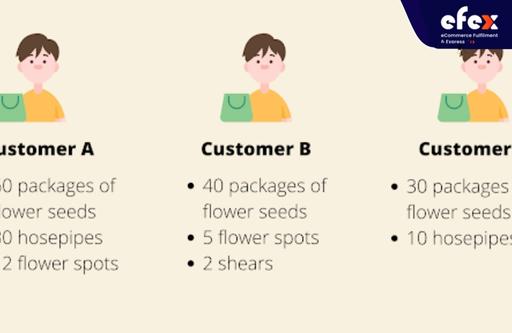
More Helpful Content
Warehouse managers now have a range of order-picking options, including discrete, zone, cluster, and voice picking. Amid these choices, batch picking remains valuable. To optimize it, invest in advanced work systems for enhanced batching. This approach boosts productivity, cost savings, and order fulfillment speed without major architectural changes or heavy automation. Today, EFEX will delve into the specifics of the batch picking system, encompassing its usage, benefits, and strategies.

Batch picking or batching or multi-order picking is an order picking process in which the pickers gather products for numerous orders at the same time. Since batch picking decreases warehouse travel time, it is often quicker than most other picking techniques, like the single order picking method, in which pickers work solely on a single order per time. Pickers report traveling up to 10 miles per day to do their duties.
However, batch picking removes the requirement to return to the same picking area numerous times in a shift when they complete orders, considerably reducing travel time.
👉 Read More: What is Pick to Box? How to use it effectively in 2024

One picker chooses a group of orders at the same time in batch picking. When completing several orders, the aim is to construct an effective pick route that saves pickers from reaching the same product position numerous times. While warehouse managers plan to select windows or waves during the day in wave picking. The objective Orders are routed to fulfillment depending on their contents, so that similar orders may be completed together.
In several warehouses, batch picking is a popular method of order fulfillment. The most basic definition of batch picking is when a worker selects many goods from the same SKU to utilize in various orders. Because batch order picking at a warehouse minimizes the frequency a worker has to travel to a place, it is quicker and more accurate.

While the primary goal of order picking is to finish client orders as rapidly as possible while providing a full and error-free order. Whether you employ single order picking or numerous order packing, every step must be completed accurately in order to meet demand and inspire customer loyalty and repeat business.
The pickers will choose many orders at the same time in cluster picking. In contrast to batch picking, in which the pickers select the same SKUs for different orders, cluster picking often includes orders that are not identical. To make cluster picking function smoothly, the pickers will often use an order picking cart or AMR that contains compartments for several orders and will automatically route the pickers to the position of the next SKU.
Cluster picking reduces travel time while picking orders, increasing operational efficiency. However, it is not as effective as batch selecting. As a result, cluster picking is frequently preferable for businesses that must handle a high number of orders at once but do not frequently process identical orders.
Batches are often made up of 8 to 20 comparable orders that are aggregated into one select checklist. Orders that have been batch-processed typically feature multiple of the same products or even highly identical select pathways.
It is critical to employ a WMS and OMS (order management system) to develop efficient batch grouping and pick routes. These two systems may evaluate orders as well as your individual warehouse design to generate picking plans that reduce trip time, allowing you to spend more time selecting and less time moving.

Batch picking may be incredibly productive since workers can choose numerous SKUs for multiple orders in just one trip instead of making separate, recurring excursions across the warehouse. Furthermore, clustering choices imply that fewer individuals are passing across warehouse aisles at the same time. This results in fewer bottlenecks, allowing workers to get to their destinations faster. The orders must next be sorted into their appropriate boxes in the packaging facilities.
Batch picking is a very simple operation when a warehouse management system or order management system is used to calculate ideal batches and map picking paths.

A warehouse management system or order management system often creates a combined list that includes quantities, SKUs, and inventory storage places. Picking lists can be made by hand, but these systems can bundle related orders, like those with these same SKUs or that need similar pick pathways to streamline picking processes and decrease trip time.
Pickers get their picking list and assemble any appropriate tools, like carts, totes, and mobile scanners, to perform each order. Some processes may include extra technologies, such as voice-picking headsets, which guide the selector to the position of every item in an order.
Pickers can gather objects in a variety of methods, depending on the specific needs of the company. Pickers in certain warehouses may wheel a cart containing multiple tiny distinct bags per order, whilst employees in others may pick straight into shipment packages.

Others may group all similar SKUs into one box, which is then delivered to the packaging staff to be separated and ready for delivery. Pickers, regardless of method, follow their selecting lists down the specified path, concentrating on a single SKU at a time. Mobile barcode scanners are frequently used by workers to record when they select an item and the needed quantity.
Unless orders were categorized and put into boxes during the selection process, the chosen things are delivered to workers who take responsibility to sort and divide the products into their corresponding orders. After that, the orders are properly packaged and ready for shipment. Afterward, the picker starts working on the following batch.
Quick, precise selection is critical not just for streamlining order fulfillment procedures, but also for a company's long-term profitability. Consumers are more highly satisfied and become regular customers once they receive the correct orders fast.
Batch picking seems to be more effective

Consider the following example to understand better the batch selecting process. Consider the following three client orders

Instead of choosing each client’s purchase one at a time, a warehouse picker utilizing batch picking would first choose all 130 packages of flower seeds for all three customers and deposit them in a specified tote on a push cart. The picker then gathers all 40 hosepipes and inserts them in a separate bag within the same cart. The picker then gathers the 2 shears for buyer B and sets them in a different container.
The picker delivers all the packages of flower seeds, hosepipes, and shears to the sorting areas before selecting the flower spots for buyers A and B, which are enormous and cannot be accommodated by the pushcart.
Then, the picker utilizes a pallet jack to load all 35 flower spots onto a single pallet and transports it to the sorting room to be sorted and packaged for transportation with some other items.
The advantages of batch selection may be extended even more by utilizing order management systems, warehouse management systems, and inventory management solutions. An order management system, for instance, may handle an order's life cycle automatically, from the time it is placed until the time it is dispatched.
The order data may be used by the OMS to automate order processing, removing manual procedures that might cause bottlenecks and human mistakes and making it simpler to fulfill orders timely and accurately.

Conversely, a WMS can handle all distribution hub resources automatically. A warehouse management system (WMS) can assist businesses in keeping track of warehouse layout, bin placements, and inventory. It may also aid in the avoidance of overstock and stockouts, and it may be linked to warehouse technologies such as barcode scanners, allowing pickers to easily confirm when orders have been picked.
Furthermore, a WMS may leverage data to improve warehouse management duties such as designing optimal pick tactics depending on usual order styles and warehouse architecture. Moreover, inventory management software can increase order picking productivity since it gives a real-time inventory perspective. This is especially effective in warehouses with quick merchandise that must be refreshed often.
Spending time waiting for SKUs to be supplied is lost time, and orders take more time to deliver. Inventory management software helps keep a record of which goods require to be refilled and when ensuring that pickers are never having to wait for orders to be filled. Batch picking allows order selectors to choose many goods for several orders at the same time, which helps warehouses and distribution facilities fulfill orders more effectively.
When integrated with automated systems and software such as a warehouse management system or order management system, the process of order picking may be further streamlined, allowing businesses to deliver orders to consumers more quickly and accurately.
Batching order strategies contain two methods. The first method which is FIFO Batching is usually performed in a WMS. While the second approach which is Intelligent Batching may be carried out in a sophisticated warehouse execution system.
Traditional pick pathways will take a picker through a serpentine pick path to get all of the goods for each order. A basic warehouse management system will group orders in this manner. Without regard for travel distance or other circumstances, the batching algorithms operate on a first-in, first-out basis, which means that order 1 will be batched with order 2, etc.

Despite this approach being faster than typical discrete picking which is picking a single order at a time, there is still a better method to group orders. To optimize the trip reductions in a batch selection approach, we must consider product placements, beginning and terminating places, and probable journey paths.
The next batching approach employs algorithms related to AI to create more optimal ordering batches. This is called "intelligent batching." In a complex warehouse operating system, this batching strategy uses order, inventories, and location information from the warehouse management system and other systems to produce batch allocations, which are subsequently optimized in real-time.
This technique incorporates order priority, picking a location, trip cost, product features, and other aspects to construct optimum batches of work, as opposed to basic rule-based batching employed in a WMS (like FIFO or product and location overlap). "Intelligent batching" considers millions of possible combinations to select the "best batch" or group of jobs among the current orders.

The math underlying this is difficult. There will be more than 41 million unique possibilities if there are 1000 orders available for batching and you try to construct batches of four orders. As people on the floor request tasks, the sophisticated system cycles through the permutations in just a second. DCs that use this batching strategy have decreased travel by nearly 70% with more than doubled picking efficiency, and reduced work hours by 50%.
👉 Read More: All Cost To Rent A Warehouse In 2024
Certainly, by using batch picking, your workers may not receive as much activity as they used to when they ran around the warehouse floor, sometimes returning to the same area numerous times. Since pickers are designed to focus on a single SKU at a time, training is often considerably quicker and more basic than other picking tactics that need the picker to master the design of the whole warehouse. Unfortunately, it is not like every warehouse or business is well-suited to batch picking. Before committing to one order selection strategy or method, ensure to evaluate all others.


